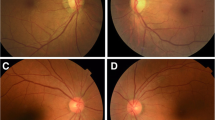Abstract
Our aim is to demonstrate the benefits of using a computer model to support the clinical diagnosis of complex eye motility disorders. For diagnosis and differential diagnosis we compared the clinical data of a patient with suspected monocular elevation deficiency (MED) and the corresponding computer simulation with the simulations of rectus superior palsy, vertical Duane miswiring syndrome and two simulations of asymmetric gaze palsy. We used our biomechanical eye model SEE-KID for the computer simulations, which is partly based on ideas and concepts of the software system Orbit™ by Joel Miller. A young patient with the clinical characteristics of congenital MED, unilateral limitation of up-gaze above midline, with accompanying ptosis on the affected right side, mild head posture, chin-up position, partial binocular functions and Bell’s phenomenon was examined. Pupillary situation, cover test, version and duction movements, saccadic test, Parks–Bielschowsky phenomenon and head tilt test, stereopsis test, Bagolini striated lens test and forced duction test were assessed. Up to the age of 5 years we used the prism cover test in the nine main gaze positions; later we switched to the Hess-Lancaster test for analyzing deviations. We also used our computer model for evaluating the diagnosis and for differential diagnosis of our patient. The simulation results from the SEE-KID model support the diagnosis of supranuclear MED, which can be achieved in the model by varying central innervations, contrary to the modification of muscle forces in the simulation of a rectus superior palsy. It is necessary to distinguish between supranuclear, nuclear, interstitial or peripheral lesions with regard to monocular elevation deficit. Simulations of patients with similar pathologies in a way that the simulations correspond to the patient-measured values support (beside the clinical signs) the diagnosis of supranuclear or infranuclear lesions.






Similar content being viewed by others
References
White J (1942) Paralysis of the superior rectus and the inferior oblique muscle of the same eye. Arch Ophthalmol 2(27):366–371
Jampel R, Fells P (1968) Monocular elevation paresis caused by a central nervous system lesion. Arch Ophthalmol 1(80):45–57
Demer J, Oh S, Poukens V (2000) Evidence for active control of rectus extraocular muscle pulleys. Invest Ophthalmol Vis Sci 41:1280–1290
Kommerell G, Mattheus S (1984) Reversed fixation test (RFT): a new tool for the diagnosis of dissociated vertical deviation (DVD) and dissociated horizontal deviation (DHD). In: Reinecke RD (ed) Strabismus II. Grune and Stratton, Orlando, pp 721–728
Buchberger M (2008) Biomechanical modelling of the human eye. Vdm Verlag Dr. Müller, Saarbrücken
Haslwanter T, Buchberger M, Kaltofen T, Hörantner R, Priglinger S (2005) SEE++ a biomechanical model of the oculomotor plant. Ann N Y Acad Sci 1039(1):9–14
Priglinger S, Buchberger M (2004) Augenmotilitätsstörungen. Springer, Wien
Buchberger M, Kaltofen T, Priglinger S, Hörantner R (2003) Construction and application of an object-oriented computer model for simulating ocular positioning defects. Spektrum Augenheilkd 17:151–157
RISC Software GmbH, Buchberger M, Kaltofen T, Priglinger S (2003) SEE++ user manual. Research Unit Medical-Informatics, Hagenberg
Miller J (1999) Orbit™ 1.8 gaze mechanics simulation—users manual. Eidactics, San Francisco
Metz H (1979) Double elevator palsy. Arch Ophthalmol 97:901
Thoemke F (2001) Augenbewegungsstörungen. Thieme Verlag, Germany
Dunlap E (1952) Diagnosis and management of double elevator palsy. Trans Am Ophthalmol Soc 3:1554
Dunlap EA (1971) Symposium on strabismus: transactions of the New Orleans Academy of Ophthalmology. Chap. 17. Vertical displacement of horizontal recti. CV Mosby, St. Louis, pp 307–329
Knapp P (1969) The surgical treatment of double elevator palsy. Trans Am Ophthalmol Soc 67:304
Von Norden G, Hansell R (1991) Clinical characteristics and treatment of isolated inferior rectus paralysis. Ophthalmology 98:253
Cuttone J, Brazis P, Miller M (1979) Absence of the superior rectus muscle in Apert`s syndrome. J Pedriatr Ophthalmol Strabismus 16:349
Buchberger M, Kaltofen T, Priglinger S, Mühlendyck H (2009) Computer simulation of brown syndrome, European strabismological association, 33rd meeting, Belgrade, Serbia, 2009
Ziffer A, Rosenbaum A, Demer J (1992) Congenital double elevator palsy; Vertical saccadic velocity utilizing the sclera search coil technique. J Pediatr Ophthalmol Strabismus 29:142
Thames P, Trobe J, Ballinger W (1984) Upgaze paralysis caused by lesion of the periaqueductal gray matter. Arch Neurol 41:437
Steffen H (2006) Topodiagnostik supranukleärer Augenbewegungsstörungen. Der Ophthalmologe. 103:977–990
Buttner–Ennever J, Buttner U, Cohen B (1982) Vertical glaze paralysis and the rostral interstitial nucleus of the medial longitudinal fasciculus. Brain 105:125–149
Buttner–Ennever J, Acheson J, Buttner U (1989) Ptosis and supranuclear downgaze paralysis. Neurology 39:385
Bender M (1980) Brain control of the structural and fuctional correlates. Brain 103:23
Guyton D (2004) Dissociated vertical deviation: an acquired nystagmus blockage phenomenon. Am Orthoptic J 54(1):77–87
Traboulsi E (2007) Congenital cranial dysinnervation disorders and more. J AAPOS 11(3):215–217
Helveston E (1993) A logical scheme for the planning of strabismus surgery. In: Craven L (ed) Surgical management of strabismus: an atlas of strabismus surgery, 4th edn. Mosby Year Book, St. Louis, pp 355–389
Declaration of Interest
The SEE++ software system (www.see-kid.at) can be purchased from the Research Unit Medical-Informatics of the RISC Software GmbH, which employs one author of this paper. The RISC Software GmbH (www.risc-software.at) is a non-profit organization owned by the Johannes Kepler University of Linz and the Upper Austrian Research GmbH and any earnings are reinvested into further development of the SEE++ software system.
Author information
Authors and Affiliations
Corresponding author
Rights and permissions
About this article
Cite this article
Priglinger, S., Rohleder, M., Reitböck, S. et al. Computer-assisted diagnosis of monocular elevation deficiency. Int Ophthalmol 34, 185–195 (2014). https://doi.org/10.1007/s10792-013-9809-4
Received:
Accepted:
Published:
Issue Date:
DOI: https://doi.org/10.1007/s10792-013-9809-4




